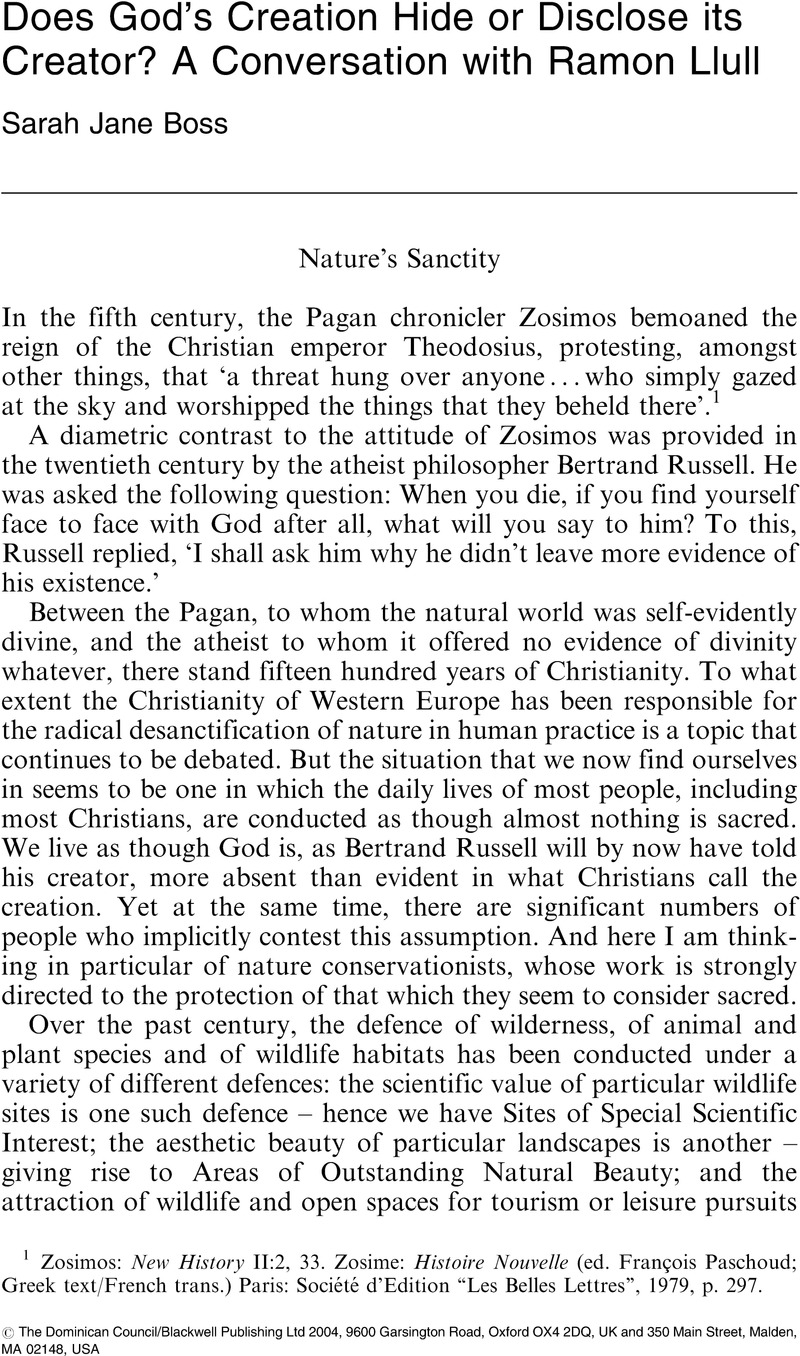Article contents
Does God's Creation Hide or Disclose its Creator? A Conversation with Ramon Llull
Published online by Cambridge University Press: 01 January 2024
Abstract

- Type
- Catholic Theological Association 2003 Conference Papers
- Information
- Copyright
- Copyright © The Dominican Council/Blackwell Publishing Ltd 2004
References
1 Zosimos: New History II:2, 33. Zosime, : Histoire Nouvelle(ed. Paschoud, François; Greek text/French trans.) Paris: Société d’Edition “Les Belles Lettres”, 1979, p. 297Google Scholar.
2 Milton, Kay: Loving Nature: Towards an Ecology of Emotion, London and New York: Routledge, 2002, p. 143Google Scholar.
3 Kay Milton: Loving Nature, p. 144.
4 A biography and English trans. of the Vita Coetanea of Llull is given in Bonner, Anthony (ed. and trans.): Doctor Illuminatus: A Ramon Llull Reader, Princeton, NJ: Princeton University Press, 1994, pp. 1–44Google Scholar.
5 Vega, Amador: Ramon Llull y el Secreto de la Vida, Madrid: Ediciones Siruela, 2002Google Scholar
6 Quoted in Vega: Ramon Llull, p. 65.
7 Wright, M.R.: Cosmology in Antiquity, London: Routledge, 1995, pp. 56–74Google Scholar.
8 Funkenstein, Amos: Theology and the Scientific Imagination from the Middle Ages to the Seventeenth Century, Princeton, NJ: Princeton University Press, 1986, p. 28Google Scholar.
9 Hildegard of Bingen: On Natural Philosophy and Medicine: Selections from Cause et Cure (trans. Berger, Margaret), Woodbridge, Suffolk: Boydell and Brewer, 1999, p. 24Google Scholar (trans. amended). An overview of Hildegard's understanding of the relationship between the cosmos and microcosm is given in Flanagan, Sabina: Hildegard of Bingen: A Visionary Life, London and New York: Routledge, 1990, pp. 141–157Google Scholar.
10 Hildegard: Natural Philosophy, p. 29.
11 Hildegard: Natural Philosophy, p. 36.
12 Lulius, Raymundus: Libro de la Concepcion Virginal(Latin text/Spanish trans. by Alonzo de Zepada), Brussels: Baltasar Vivien, 1664, p.Google Scholar
13 Vega: Ramon Llull, p. 58.
14 Hames, Harvey: The Art of Conversion: Christianity and Kabbalah in the Thirteenth Century, Leiden: Brill, 2000, p. 191CrossRefGoogle Scholar.
15 Vega: Ramon Llull, p. 60.
16 Amador Vega: Ramon Llull, p. 62.
17 Breton, David Le: Anthropologie du Corps et Modernité, Paris: Quadrige/Presses Universitaires de France, 1990Google Scholar
18 Le Breton: Anthropologie du Corps, pp. 22–28.
19 For a detailed and intelligent discussion of European tales of metamorphosis, see Walker-Bynum, Caroline: Metamorphosis and Identity, New York: Zone Books, 2001Google Scholar.
20 The Quest of the Holy Grail(trans. Matarasso, P.M.), Harmondsworth: Penguin Books, 1969Google Scholar
21 D’Arcy, Anne Marie: Wisdom and the Grail: The Image of the Vessel in the “Queste Del Saint Graal” and Malory's “Tale of Sankgreal”, Dublin: Four Courts Press, 2000, pp. 80–81, n.36Google Scholar.
22 Le Breton: Anthropologie du Corps, p. 46.
23 ‘Third Letter of Cyril to Nestorius’, from the documents of the Council of Ephesus (431), in Tanner, Norman P. SJ (ed.): Decrees of the Ecumenical Councils, London: Sheed & Ward, and Washington: Georgetown University Press, 1990, vol. 1, p. 58Google Scholar.
24 St. Cyril of Alexandria: On the Unity of Christ(trans. McGuckin, John Anthony), Crestwood, NY: St. Vladimir's Seminary Press, 1995, p. 57Google Scholar.
25 St. Cyril: Unity, p. 59.
26 Kelly, J.N.D.: Early Christian Doctrines, London: A. & C. Black, 1977, p. 297Google Scholar.
27 Vita Coetanea 26, in Bonner: Doctor Illuminatus, p. 28.
28 Bonner: Doctor Illuminatus, p. 50.
29 Ars Brevis, Part I, Table 3, in Bonner: Doctor Illuminatus, pp. 289–364, at p. 299.
30 Ramon Llull: Tractat d’Astronomia, Nova Edició de les Obres de Ramon Llull, Volum V (ed. Lola Badia), Barcelona: Publicacions de l’Abadia de Montserrat, 2002, pp. 185–186. A discussion of this work can be found in Yates, Frances A.: ‘The Art of Ramon Lull: An Approach to it through Lull's Theory of the Elements’, in Lull and Bruno: Collected Essays London: Routledge & Kegan Paul, 1982, pp. 9–77Google Scholar.
31 Most notably, Frances Yates, ‘Ramon Lull and John Scotus Erigena’, in Lull and Bruno, pp. 78–125.
32 Iohannis Scottus Eriugena: Periphyseon (De Divisione Naturae) I, ed. Sheldon-Williams, I.P.. Dublin: Dublin Institute for Advanced Studies, 1968, pp. 36–39Google Scholar.
33 Eriugena: Periphyseon, III (1981), pp. 30–33.
34 Nicholas of Cusa: On God as Not-Other: A translation and an Appraisal of De li Non Aliud (Latin text, with English trans. and notes by Jasper Hopkins), Minneapolis: University of Minnesota Press, 1979, p. 1118Google Scholar: ‘I might say that God is none of the visible things, since He is their cause and creator. And I might say that in the sky He is not other than the sky.’
- 1
- Cited by




